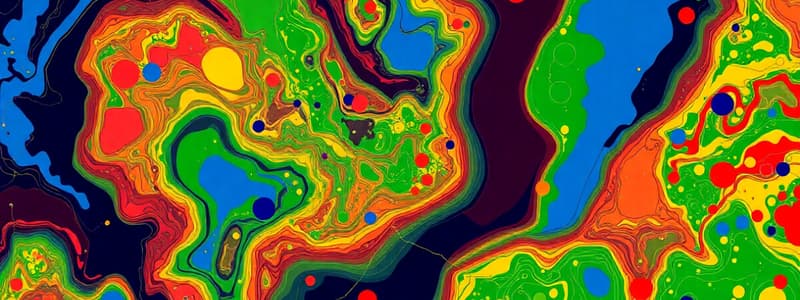Podcast
Questions and Answers
A geographer is studying the impact of a new highway on local businesses. Which scale of analysis would be most appropriate for this study?
A geographer is studying the impact of a new highway on local businesses. Which scale of analysis would be most appropriate for this study?
- Global
- National
- Regional
- Local (correct)
Which of the following scenarios exemplifies the use of remote sensing in geographical studies?
Which of the following scenarios exemplifies the use of remote sensing in geographical studies?
- Conducting interviews with residents to understand urban development patterns.
- Analyzing satellite imagery to monitor deforestation rates in the Amazon rainforest. (correct)
- Using census data to map population density in a metropolitan area.
- Creating a GIS map of local businesses.
A clothing company decides to open a new factory. They analyze multiple locations based on proximity to cotton fields, major transportation routes, and energy sources. Which concept of geography are they utilizing?
A clothing company decides to open a new factory. They analyze multiple locations based on proximity to cotton fields, major transportation routes, and energy sources. Which concept of geography are they utilizing?
- Relative location (correct)
- Scale of analysis
- Human-environment interaction
- Absolute location
How does the concept of 'space' influence the study of urban planning and development?
How does the concept of 'space' influence the study of urban planning and development?
A geographer wants to determine the precise coordinates of a remote mountain peak for mapping purposes. Which tool would be most effective for this task?
A geographer wants to determine the precise coordinates of a remote mountain peak for mapping purposes. Which tool would be most effective for this task?
A region is defined as having a particular climate, certain religious demographics, and a specific style of architecture? What type of region is this?
A region is defined as having a particular climate, certain religious demographics, and a specific style of architecture? What type of region is this?
How might the scale of analysis affect a study on access to healthy food?
How might the scale of analysis affect a study on access to healthy food?
What distinguishes a place from a space in geographic terms?
What distinguishes a place from a space in geographic terms?
Flashcards
What are Maps?
What are Maps?
Visual tool for analyzing spatial information, showing political boundaries, physical features, or population density.
What are GIS and Remote Sensing?
What are GIS and Remote Sensing?
Technologies that gather and analyze Earth data. GIS creates maps and analyzes spatial data while remote sensing collects data from afar.
What is Absolute Location?
What is Absolute Location?
The exact location of a place, often expressed using latitude and longitude.
What is Relative Location?
What is Relative Location?
Signup and view all the flashcards
What is Space?
What is Space?
Signup and view all the flashcards
What is Place?
What is Place?
Signup and view all the flashcards
What is Human-Environment Interaction?
What is Human-Environment Interaction?
Signup and view all the flashcards
What is Scale of Analysis?
What is Scale of Analysis?
Signup and view all the flashcards
Study Notes
- Unit 1 provides the basic tools and concepts for geographic thinking
Maps and Tools
- Maps are crucial for visualizing and analyzing spatial information
- Different maps display various features like political boundaries, physical attributes, or population density
- GIS (Geographic Information Systems) uses computers to map and analyze spatial data
- Remote sensing gathers data from a distance, often via satellites
Location
- Absolute location is an exact spot, defined by coordinates such as latitude and longitude
- Relative location describes where something is in relation to other things nearby
Spatial Concepts
- Space is the area between things, and geographers study how arrangements and interactions occur within it
- Place refers to a specific point on Earth distinguished by unique attributes
- These attributes include physical features, human characteristics, or human interactions
Human-Environment Interaction
- This interaction explores how humans and the environment impact one another
- Humans rely on the environment for resources but also change it through actions
Scale of Analysis
- Geographers examine phenomena at different scales, from local to global perspectives
- The chosen scale influences what is observed and subsequent interpretations
Regions
- Regions are areas grouped by shared characteristics such as climate, culture, or economic activities
Studying That Suits You
Use AI to generate personalized quizzes and flashcards to suit your learning preferences.
Description
Explore geographic thinking with maps and spatial analysis. Learn about Geographic Information Systems (GIS) and remote sensing techniques. Understand absolute and relative location, spatial concepts, and human-environment interaction.




